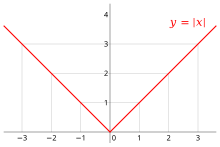
Back Absolute waarde Afrikaans ንጥረ እሴት Amharic قيمة مطلقة Arabic Mütləq qiymət Azerbaijani Абсалютная велічыня Byelorussian Абсалютная велічыня BE-X-OLD Абсолютна стойност Bulgarian পরম মান Bengali/Bangla ཚུགས་ཐུབ་རིན་ཐང་། Tibetan Apsolutna vrijednost BS


In mathematics, the absolute value or modulus of a real number , denoted , is the non-negative value of without regard to its sign. Namely, if is a positive number, and if is negative (in which case negating makes positive), and . For example, the absolute value of 3 is 3, and the absolute value of −3 is also 3. The absolute value of a number may be thought of as its distance from zero.
Generalisations of the absolute value for real numbers occur in a wide variety of mathematical settings. For example, an absolute value is also defined for the complex numbers, the quaternions, ordered rings, fields and vector spaces. The absolute value is closely related to the notions of magnitude, distance, and norm in various mathematical and physical contexts.





